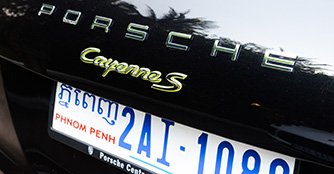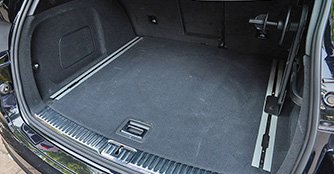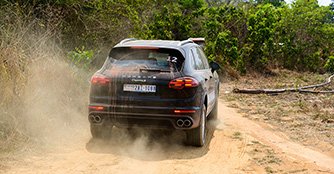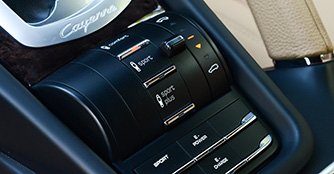Porsche Cayenne S E-Hybrid 3.0 (A) First Drive Review
17 Jun 2016|83,805 views
Electricity is fast becoming the driving force for performance car makers, including Porsche. The German sports carmaker's limited edition 918 Spyder blends traditional V8 horsepower with electric motors to create the brand's quickest road car ever and also forms the basis for Porsche's motorsport prowess in the World Endurance Championship.
There is also the Panamera S E-Hybrid, the brand's four-door luxury grand tourer that was the first Porsche hybrid in Singapore to feature charging capabilities direct from the socket.
Porsche's popular Sport Utility Vehicle (SUV), the Cayenne, is next to follow in these tracks by being the third plug-in hybrid offering. And while it's not the first plug-in Porsche, it is the first premium SUV to offer that ability.
Available in six different versions locally, the Cayenne spans a massive range and engine choices alone are staggering. Six cylinders, eight cylinders, turbochargers, superchargers and even a diesel can be had in Porsche's SUV. But the most interesting of them all, or at least the most unique, has to be the Cayenne S E-Hybrid that you see here.
Up close and Personal
Truth be told, this vehicle is an eye-catching one, with its vibrant green detailing. From the brake calipers to the various hybrid badges around the car, the S E-Hybrid is easily distinguished from its quartet of diesel and petrol siblings. It simply makes you stop and take notice.
 |
Retaining the basic shape of the Cayenne, the facelifted model features sharper lines, updated front fenders, a larger hood, a revised rear bumper that integrates with the tailpipes, and new aerodynamic fins on each side of the front end.
Another highlight feature is the Bi-Xenon head lights, now with a more angular shape. Also, Porsche's characteristic four-point daytime running lights come standard with this car.
Inside the car, the acid green treatment is more subdued as only the gauge needles are finished in the attention-seeking colour. These indicators sit in hybrid-specific instruments (power meter replaces speedometer) that occupy the area behind a new steering wheel, inspired by the 918 Spyder.
That aside, it's familiar fare, which isn't a bad thing because the Cayenne's cabin is reasonably spacious and very well-finished. It's easy to get comfortable behind the wheel, thanks to electrically adjustable leather seats that come as standard, and there's plenty of room for tall adults to stretch out in front or behind.
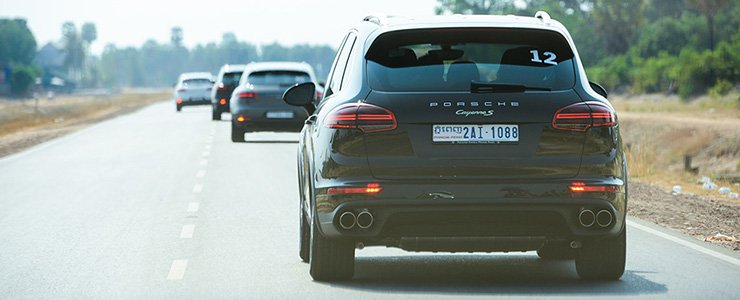 |
The Drive
Under the hood, the 3.0-litre supercharged V6 engine combines with a 70kW electric motor for a total system output of 410 Stuttgartian horses and 590Nm of torque.
Despite its size and heft, this 2,350kg SUV, using an eight-speed automatic transmission, zips from 0 to 100km/h in just 5.9 seconds, 1.7 seconds faster than the base Cayenne and 1.4 seconds faster than the Cayenne Diesel.
But what's more impressive is how the S E-Hybrid stops, or rather how it decelerates. The regenerative braking actually features some modulation in the pedal and doesn't operate with the on/off action of some other hybrids we have experienced before.
This is a light at the end of a long and dark tunnel of non-linear hybrid brake feel. It may not be perfect and remains to be meagre, but it's an exciting step for enthusiasts and evidence that electrification isn't the end of all things fun.
As with other plug-in hybrids, overall efficiency is largely a matter of how often you can keep the battery charged to run the vehicle more efficiently on the electric motor, although we didn't get to explore much of the car's electric functionality during our time with it in Cambodia.
Unlike a normal Cayenne, this plug-in hybrid model has an optional on-board charger with 7.2kW, which reduces charging time to about 90 minutes for a full charge.
Alternatively, the standard Porsche Universal Charger using a conventional household or industrial outlet grants a full strength battery in about three hours. And if you are on the move, the regenerative braking and e-Charge mode can get the battery to 80 percent strength after 30 minutes of combined city and highway driving.
With the ideal charging conditions, the SUV can typically cover around 18km to 36km under electric power alone. Nonetheless, this is still dependent on several factors such as driving style, traffic situation, number of passengers or load, etc.
There are few dynamic measures by which the Cayenne doesn't dominate the SUV world, and that trait survives in this plug-in hybrid variant. A stiff structure fortifies taut body control and together with a sharp steering, you can string a few corners with surprising precision.
Conclusion
The Cayenne S E-Hybrid has a do-gooder psyche and it's liveable as a regular car despite its green intentions. In fact, it is possible to get inside and drive this car without even realising it's part electric.
The electrification of automobiles is on the horizon and Porsche is applying its formidable engineering acumen to the petrol/hybrid equation in both its road vehicles and endurance racers. And that might just be the start of something big.
Electricity is fast becoming the driving force for performance car makers, including Porsche. The German sports carmaker's limited edition 918 Spyder blends traditional V8 horsepower with electric motors to create the brand's quickest road car ever and also forms the basis for Porsche's motorsport prowess in the World Endurance Championship.
There is also the Panamera S E-Hybrid, the brand's four-door luxury grand tourer that was the first Porsche hybrid in Singapore to feature charging capabilities direct from the socket.
Porsche's popular Sport Utility Vehicle (SUV), the Cayenne, is next to follow in these tracks by being the third plug-in hybrid offering. And while it's not the first plug-in Porsche, it is the first premium SUV to offer that ability.
Available in six different versions locally, the Cayenne spans a massive range and engine choices alone are staggering. Six cylinders, eight cylinders, turbochargers, superchargers and even a diesel can be had in Porsche's SUV. But the most interesting of them all, or at least the most unique, has to be the Cayenne S E-Hybrid that you see here.
Up close and Personal
Truth be told, this vehicle is an eye-catching one, with its vibrant green detailing. From the brake calipers to the various hybrid badges around the car, the S E-Hybrid is easily distinguished from its quartet of diesel and petrol siblings. It simply makes you stop and take notice.
Retaining the basic shape of the Cayenne, the facelifted model features sharper lines, updated front fenders, a larger hood, a revised rear bumper that integrates with the tailpipes, and new aerodynamic fins on each side of the front end.
Another highlight feature is the Bi-Xenon head lights, now with a more angular shape. Also, Porsche's characteristic four-point daytime running lights come standard with this car.
Inside the car, the acid green treatment is more subdued as only the gauge needles are finished in the attention-seeking colour. These indicators sit in hybrid-specific instruments (power meter replaces speedometer) that occupy the area behind a new steering wheel, inspired by the 918 Spyder.
That aside, it's familiar fare, which isn't a bad thing because the Cayenne's cabin is reasonably spacious and very well-finished. It's easy to get comfortable behind the wheel, thanks to electrically adjustable leather seats that come as standard, and there's plenty of room for tall adults to stretch out in front or behind.
The Drive
Under the hood, the 3.0-litre supercharged V6 engine combines with a 70kW electric motor for a total system output of 410 Stuttgartian horses and 590Nm of torque.
Despite its size and heft, this 2,350kg SUV, using an eight-speed automatic transmission, zips from 0 to 100km/h in just 5.9 seconds, 1.7 seconds faster than the base Cayenne and 1.4 seconds faster than the Cayenne Diesel.
But what's more impressive is how the S E-Hybrid stops, or rather how it decelerates. The regenerative braking actually features some modulation in the pedal and doesn't operate with the on/off action of some other hybrids we have experienced before.
This is a light at the end of a long and dark tunnel of non-linear hybrid brake feel. It may not be perfect and remains to be meagre, but it's an exciting step for enthusiasts and evidence that electrification isn't the end of all things fun.
As with other plug-in hybrids, overall efficiency is largely a matter of how often you can keep the battery charged to run the vehicle more efficiently on the electric motor, although we didn't get to explore much of the car's electric functionality during our time with it in Cambodia.
Unlike a normal Cayenne, this plug-in hybrid model has an optional on-board charger with 7.2kW, which reduces charging time to about 90 minutes for a full charge.
Under the hood, the 3.0-litre supercharged V6 engine combines with a 70kW electric motor for a total system output of 410 Stuttgartian horses and 590Nm of torque.
Despite its size and heft, this 2,350kg SUV, using an eight-speed automatic transmission, zips from 0 to 100km/h in just 5.9 seconds, 1.7 seconds faster than the base Cayenne and 1.4 seconds faster than the Cayenne Diesel.
But what's more impressive is how the S E-Hybrid stops, or rather how it decelerates. The regenerative braking actually features some modulation in the pedal and doesn't operate with the on/off action of some other hybrids we have experienced before.
This is a light at the end of a long and dark tunnel of non-linear hybrid brake feel. It may not be perfect and remains to be meagre, but it's an exciting step for enthusiasts and evidence that electrification isn't the end of all things fun.
As with other plug-in hybrids, overall efficiency is largely a matter of how often you can keep the battery charged to run the vehicle more efficiently on the electric motor, although we didn't get to explore much of the car's electric functionality during our time with it in Cambodia.
Unlike a normal Cayenne, this plug-in hybrid model has an optional on-board charger with 7.2kW, which reduces charging time to about 90 minutes for a full charge.
Alternatively, the standard Porsche Universal Charger using a conventional household or industrial outlet grants a full strength battery in about three hours. And if you are on the move, the regenerative braking and e-Charge mode can get the battery to 80 percent strength after 30 minutes of combined city and highway driving.
With the ideal charging conditions, the SUV can typically cover around 18km to 36km under electric power alone. Nonetheless, this is still dependent on several factors such as driving style, traffic situation, number of passengers or load, etc.
There are few dynamic measures by which the Cayenne doesn't dominate the SUV world, and that trait survives in this plug-in hybrid variant. A stiff structure fortifies taut body control and together with a sharp steering, you can string a few corners with surprising precision.
Conclusion
The Cayenne S E-Hybrid has a do-gooder psyche and it's liveable as a regular car despite its green intentions. In fact, it is possible to get inside and drive this car without even realising it's part electric.
The electrification of automobiles is on the horizon and Porsche is applying its formidable engineering acumen to the petrol/hybrid equation in both its road vehicles and endurance racers. And that might just be the start of something big.
Car Information
Porsche Cayenne S E-Hybrid 3.0 (A)
CAT B|Petrol-Electric|29.4km/L
Horsepower
306kW (410 bhp)
Torque
590 Nm
Acceleration
5.9sec (0-100km /hr)
This model is no longer being sold by local distributor
All Used Porsche Cayenne S E-HybridThank You For Your Subscription.














